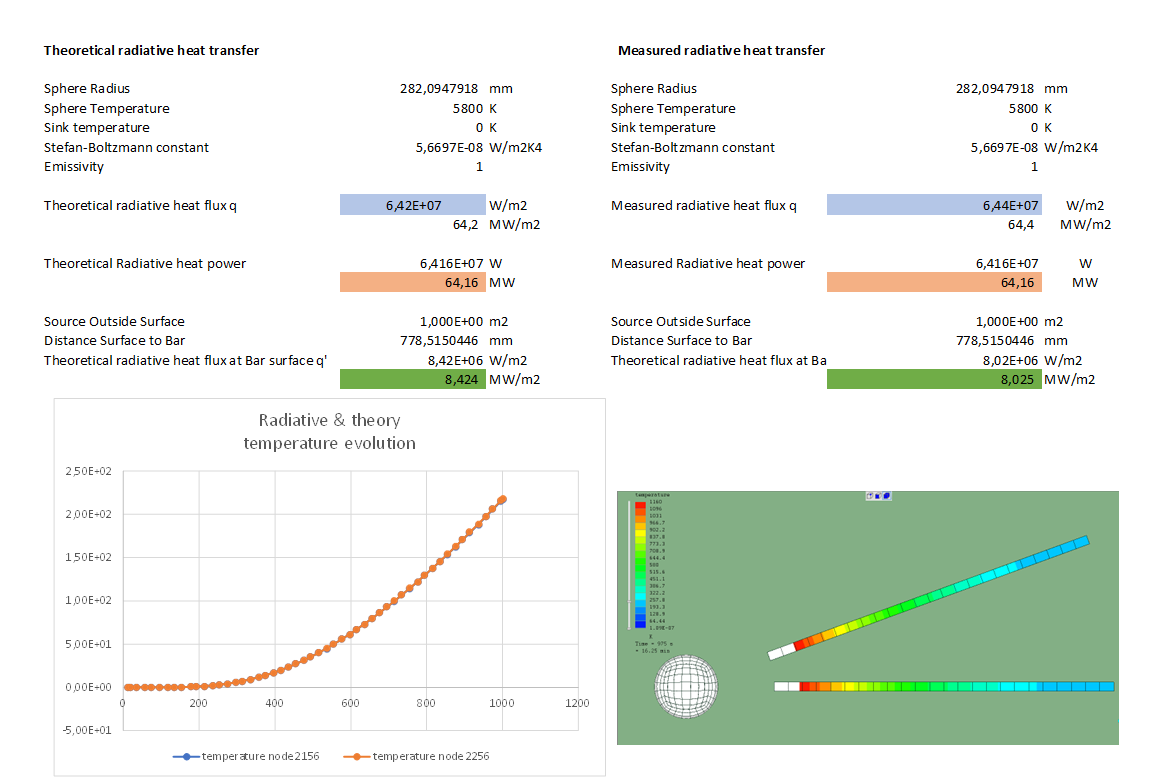Radiative thermal heat transfer & Cavity
Hi ,
I have set up a validation file of radiative heat transfer process with cavity and minimal custom cards.
There aren’t many explicit examples on the forum or the tutorial book, so I post it in raw version.
I know cavity is experimental in MECWAY yet but I gave it a try and Internal solver is able to converge but convergence is much slower and still gives “wrong” results. File is solved with ccx version included in Mecway .
@Victor, I think the Internal solver don't have automatic time stepping for thermal transient as it advances one step by one no matter how good the convergence is.
Thinks learn:
1- Temperature and *RADIATE are incompatible BC if applied to a shell surface. (I guess there is no temperature gradient so… no flux to radiate). I have spent some hours of try and error since concluding this and I think it would be interesting if users are warned by MECWAY to avoid it.
2-If one wants to keep working with shells, one could use a heat source BC instead of temperature using the Stefan-Boltzmann law.
3-One solid layer with temp on the inside is super-fast
4-Radiative surface might be confusing sometimes when reading the results because in the equilibrium, overall flux on that surface becomes almost 0.
5-Radiation is gray and diffuse.
6-Element orientation BC doesn’t seem to project Heat flux into the local axes.

I have set up a validation file of radiative heat transfer process with cavity and minimal custom cards.
There aren’t many explicit examples on the forum or the tutorial book, so I post it in raw version.
I know cavity is experimental in MECWAY yet but I gave it a try and Internal solver is able to converge but convergence is much slower and still gives “wrong” results. File is solved with ccx version included in Mecway .
@Victor, I think the Internal solver don't have automatic time stepping for thermal transient as it advances one step by one no matter how good the convergence is.
Thinks learn:
1- Temperature and *RADIATE are incompatible BC if applied to a shell surface. (I guess there is no temperature gradient so… no flux to radiate). I have spent some hours of try and error since concluding this and I think it would be interesting if users are warned by MECWAY to avoid it.
2-If one wants to keep working with shells, one could use a heat source BC instead of temperature using the Stefan-Boltzmann law.
3-One solid layer with temp on the inside is super-fast
4-Radiative surface might be confusing sometimes when reading the results because in the equilibrium, overall flux on that surface becomes almost 0.
5-Radiation is gray and diffuse.
6-Element orientation BC doesn’t seem to project Heat flux into the local axes.

Howdy, Stranger!
It looks like you're new here. If you want to get involved, click one of these buttons!


Comments
1. I can't find the problem with temperature BC and radiation on a shell surface. Could you give me a more specific example? When I try it, it fixes the surface temperature as specified and effectively ignores the radiation. That seems physically correct as the radiation would be transferring energy into/out of the same sink that regulates the temperature without going through the model.
6. For CCX, you can use GLOBAL=NO on the *EL FILE card and the reported XYZ heat flux components are actually in element coordinates instead. But it also requires an orthotropic material or Mecway won't bother to write the orientations to CCX.
1-Find attached the shell version I started to work with.
Radiation on the source surface drops from the correct value 64MW/m2 to
8MW/m2.4e-8MWEDITED: Sorry, 8MW/m2 is the value on the Tests bars. Radiation on the source surface is around 4e-8MW. It doesn’t have any sense.
6-¿How do you enable ortho on Thermal analysis?. My mechanical tab on material properties is disabled. That seems another good reason to extend Element orientations to isotropic solids.
Maybe I'm falling myself into point 4. Now I see.
The Source surface is in balance. All the heat is generated and radiated in the same point, and I can only see the Overall Heat Flux.
I did not finished the shell analysis to realize that the target was receiving the right heat flux.
I think it's solved.
You can set orthotropic in the Thermal tab of material properties.
Now you left me with little confidence too.
¿Do you remember what was wrong or did not give you the expected results?
¿Was it related with temperatures, heat fluxes, area of incluence, convergence issues...?
I have set up a test to check the Cavity tool performance.
There are four increasing in size concentric spheres with a heat source BC in the core. R=1 m, R=2 m, R=4 m, R=8m
I have stablished radiation with emissivity=1 + Cavity check for all the surfaces .
I have run a Transient thermal analysis with sufficient time for the system to find the equilibrium.
The detailed intermediate results on each sphere might be difficult to determine as spheres start to radiate back themselves once they start to increase their temperatures but, looking at the problem from the outside is should be a very simple validation. An external observer would only see one sphere radiating.
After enough time, I would expect to find the same overall heat radiated on the outer surface than the one I inject as a BC in the core.
The problem converges, everything reach an steady state and it ends up in a stable homogeneous temperature distribution on each sphere but….. it seems to be a 15% of energy which has disappear on its way from the inside to the outside.
My questions are :
¿How do I measure the overall heat leaving the outer sphere? Radiation is diffuse and I’m not completely sure that the Surface integral tool applied to the Heat Flux Vector is capturing the tangential component of the heat flux (if any).
¿Is this configuration “view factor independent” known that each sphere completely evolves the smaller ones?.
Thanks in advance
This looks like the same type of test and magnitude of error that I saw when I decided cavity radiation was too inaccurate.